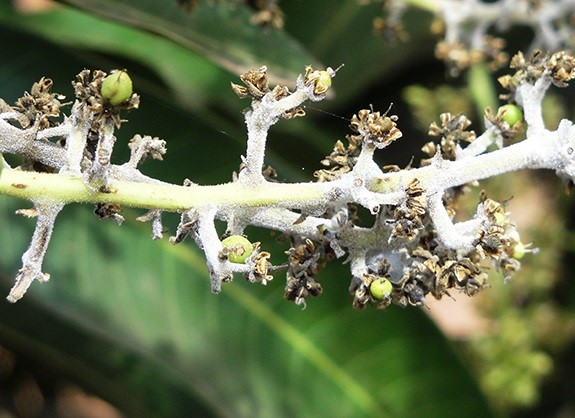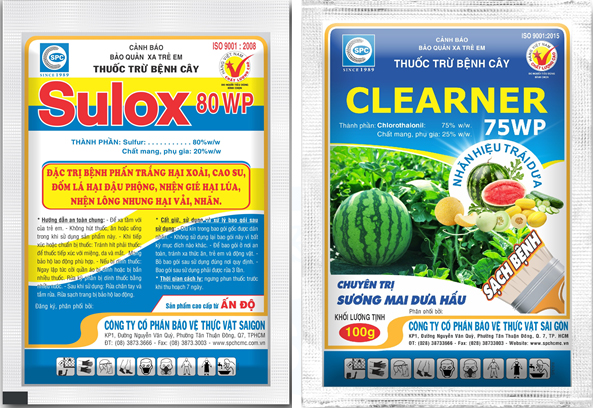|
Mangoes Damaging Powdery Mildew
16/10/2021
Ph.D Nguyen Minh Tuyen Mango is one of the fruit trees with high economic value. However, in the production process, there are many types of pests that significantly affect the yield and quality of mango. One of the dangerous pests that often appear during the mango budding season is powdery mildew. * Symptoms and effects: The disease causes damage at the stage of mango that shoots young leaves and buds, flowers and young fruit. The entire affected part is covered with a white chalk powder, especially the bunch of young fruit buds. The damaged young parts will then rot, dry out and fall off, severely affecting the mango yield. When the leaves are at a light green stage, the disease can develop on the upper surface of the leaves. When the disease is severe, the leaves will wrinkle, dry and fall, making the plant lose strength. In dense, humid garden conditions, the fungus also spreads to the old leaves, although these leaves are rarely dropped, but the fungal disease has greatly affected the photosynthesis of the plant. The disease also slows down the growth rate, or can cause tree death in mango orchards at the basic stage of construction, propagation gardens and nurseries, if not prevented. * Harmful agents and growing conditions: Powdery mildew is caused by the Oidium sp fungus. cause. The disease affects mango trees of all ages, from gardens at basic construction to commercial ones. The disease often causes severe damage in the period when mango begins to produce buds, buds, flowers and young fruit from late to early next year, especially when the environment is cool, humid and foggy. * A number of prevention measures have been applied with high efficiency: - Select less susceptible varieties to plant. - Cleaning mango orchards (collect fallen parts and burn them, or spread lime and bury them). - Balanced and reasonable fertilization. Pay attention to increase the amount of potassium fertilizer. Add extra calcium like SPC-Cal (Calcium nitrate) to help improve the soil. - Visit the garden regularly during the stage of producing buds, flowers and young fruits to make appropriate and timely prevention decisions. - Through people is many years of experience in controlling powdery mildew, it is important to pay attention to timely spraying, especially in gardens with high risk of infection, or mango orchards that were seriously diseased last year, easy to leave behind many disease residues on the tree. Carry out preventive spraying during the period of mango to produce buds, buds, flowers and young fruits from November to January of the following year. When the garden gets diseased, spray 2-3 times / batch, each time about 7-10 days. The effective and popular product that farmers often use today is SULOX 80WP or CLEARNER 75WP. - When spraying mango, it is necessary to use a sufficient amount of spray water and need a device to finely spray to the top of the tree to be effective. - Mobilize surrounding gardens to prevent diseases to reduce disease sources and avoid spreading each other.
|
To prevent, in addition to plowing and burying weed seeds, collecting weed stalks and stumps left after tilling the land to burn, not letting weeds produce seeds in production fields, etc., the use of chemical products is still a measure. optimal because of its ability to thoroughly kill weeds, reduce labor and take advantage of more time than manual weeding.
Miner has the scientific name Phyllocnistis citrella Staint., family Phyllocnistidae, order Lepidoptera. The miner occurs in many countries in the tropics and subtropics. The main host of the miner is the citrus family - Rutaceae. In addition, the miner also attacks mangosteen and some other plants.
Adult is a small planthopper, with a body 2-3 mm long, the whole body is ash gray, slightly greenish, the wings are opaque with many small brown spots.Eggs are oval, 0.3 mm long, have a pointed end and are attached directly to the leaf surface, leaf axils.
Green bugs specialize in the fruit of citrus groups (oranges, tangerines, lemons, grapefruits, kumquats...), some people call them orange bugs, or orange suckers. Their scientific name is Rhynchocoris poseidon or Rhynchocoris humeralis.
In Vietnam, yellow leaf curl disease is very common on papaya trees, especially the disease is often severe in areas of high and continuous planting, areas with hot and arid climates. The disease has significantly reduced the yield and quality of papaya. Gardens that are infected early when the plants are young may not yield. However, up to now, many gardeners still do not know the cause and how to fix it.
Spider mites are common pests on citrus trees, especially in hot and dry climates that are suitable for spiders to grow and cause severe damage.The group of harmful spiders is usually very small in size, unlike the natural enemy spiders.
This group includes species that are generally very small in size, causing damage by sucking plant sap (on leaves, fruits, branches, stems).
There are many species of mealybugs present on the group of Oranges,Tangerines,Grapefruits and Lemons (Citrus), which can be divided into 2 groups:
+ Group of sticky mealybugs with common varieties such as Lepidosaphes, Aonidiella, Coccus and Saissetia.
+ Group of flower mealybugs with common genera and species such as Pseudococcus, Planococcus and Icerya purchasi.
Dry branches and berries disease often appear to be common damage on coffee gardens during the rainy season. The disease causes death of branchs, dry fruit, severely affects the canopy structure and coffee yield if not paid attention to prevention.
Pink disease commonly causes diseases on rubber plantations in the rainy season, especially on garden from 4-8 years old. This year, rubber has to go through a period of severe drought, weakening the tree, so now in tnshe rainy season it is easy to get infected. Therefore, it is necessary to pay attention to good management to avoid affecting the garden.
In recent years, the area of citrus has been expanded because it is a fruit tree with high economic efficiency. However, in order to sell at a high price, not only in quality but consumers also require the external beauty of the fruit, so pest management on citrus is a matter of great concern to farmers. The hot season is a favorable condition for thrips to develop and cause damage, affecting the commercial value of fruit.
- Headquarters
- SAIGON PLANT PROTECTION JOINT STOCK COMPANY
- RQ 1, Nguyen Van Quy St., Tan Thuan Ward, HCM City
- Tax code: 0300632232
- Tel: (028) 38 733 295 - 38 732 077
- Fax: (028) 38 733 003 - 38 733 391
- Website: www.spchcmc.vn - Email: info@spchcmc.vn
- SAIGON PLANT PROTECTION COMPANY
- SAIGON PLANT PROTECTION JOINT STOCK ENTERPRISE
- Lot C1-C3 Hiep Phuoc Industrial Park, Hiep Phuoc Commune, HCM City
- Tel: (028) 3873 4089 - Fax: (028) 3873 4086
- Affiliated Unit
-
- Quick Links
- Home
- About us
- Career Opportunities













